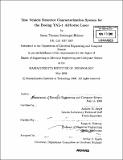Test vehicle detector characterization system for the Boeing YAL-1 airborne laser
Author(s)
Steininger-Holmes, Jason Thomas
DownloadFull printable version (23.62Mb)
Other Contributors
Massachusetts Institute of Technology. Dept. of Electrical Engineering and Computer Science.
Advisor
Andrew M. Siegel and James K. Roberge.
Terms of use
Metadata
Show full item recordAbstract
The test vehicle detector characterization system provides a convenient and efficient tool for rapidly evaluating the optical sensitivity of the GAP6012, GAP100, GAP300, and GAP1000 indium gallium arsenide detectors used on the vendor produced detector strips, which are used in the MARTI program at MIT Lincoln Laboratory. This characterization system exploits the approximately linear relationship between the radiant intensity of the gallium arsenide light emitting diodes (LEDs) and the forward current through the LEDs to correlate the expected irradiance with the observed detector counts. Illumination tests of different intensities are performed to characterize each detector's performance over its entire operating spectrum. Each test is performed multiple times to determine the statistical variance of each detector. A detector which exhibits a high statistical variance will not pass the qualifying stage. The results of these tests and others are saved and indexed by strip serial number; allowing for future reference if the need should arise. The system was developed in a modular fashion so as to be compatible with both the high power (HP) and low power (LP) detector strips with only minor hardware and firmware updates.
Description
Thesis (M. Eng.)--Massachusetts Institute of Technology, Dept. of Electrical Engineering and Computer Science, 2008. Includes bibliographical references (p. 71-72).
Date issued
2008Department
Massachusetts Institute of Technology. Department of Electrical Engineering and Computer SciencePublisher
Massachusetts Institute of Technology
Keywords
Electrical Engineering and Computer Science.